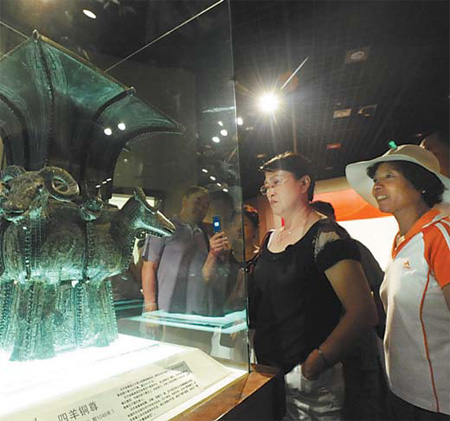Modern space, ancient relics
|
|
|
Visitors look at a 3,000-year-old bronze container in the museum. |
As old as the nation, Liaoning Provincial Museum today is much more than a collection of antiquities. In its new avatar, which opened in 2004, the museum, located in downtown Shenyang, is a "21st-century public cultural space", as its posh brochure suggests.
The number of people in its expansive circular central hall, admiring the giant Shang period (c.16th century-11th century BC) bronze food container that forms the centerpiece, on a weekday easily exceeds 5,000.
That's only one of the 120,000-odd exhibits contained in the museum. The earliest of these is the skeletal fragments of the 280,000-year-old Jinniushan Man, who is, in fact, a woman. The latest displays are specimens of calligraphy, by acclaimed artists Zhang Ding, Mabai Shuyi and Wu Zaiyan, collected as recently as this year.
The amazing turnout of visitors probably has to do with more than just academic interest. It's also about the highly professional nature of the displays, the eagerness of its almost 200 tour guides (including volunteers) and the non-overbearing, visitor-friendly feel of the place.
As the director of the museum Ma Baojie says: "The aim of the museum is primarily to serve the people, the exhibits here are the wealth of the whole world, hence we are making every effort to protect them with the utmost care."
The pride of place in this world-class museum goes to calligraphy by masters of the Tang Dynasty (AD 618-907) Zhang Xu and Huai Su, who pioneered the wild cursive script. The collection, featuring works from the Eastern Jin Dynasty (AD 317-420) to the Ming and Qing dynasties, is a graphic representation of evolving Chinese calligraphy.
Check out the fascinating range of jade jewelry worn by women of the Hongshan culture in the Neolithic period (6000-5000 BC). Quaint cloud-shaped jade pendants, superbly-crafted miniscule dragon-head pendants, and three-in-one rings with minute animal heads at either end, are sure to inspire any modern designer.
Be fascinated by the quaint and curious forms money takes. Bronze currency from the Warring States Period (475-221 BC) comes in the shape of a spade or a chopper. Western Han (206 BC-AD 24) gold horse hooves, which were used as royal gifts or collectibles, have rings and characters carved into them. The first specimens of paper currency from the Ming Dynasty (1368-1644) measure 33.9 cm by 22 cm - the size of a tabloid newspaper.
Liaoning Museum also serves as a platform for the exchange of antiquities from around the world. The calligraphy collection has been shown across 10 European countries, besides Japan and South Korea, in the past 20 years. It also hosts exhibitions from museums from the rest of China, as well as England and Japan.
The salient feature of the exhibits, says the director, is its local character. The duck-shaped flagon, excavated from the northern Yan Fengsufei tomb at Beipiao, Liaoning, between 409 and 436, was in fact imported from Syria, indicating trade through the Silk Road.
A vast number of Liao Dynasty (916-1125) relics were excavated from tomb 7 at Yemaotai Faku, in Liaoning: a green glass dish with an inlaid silver buckle; a painted wooden backgammon set, the earliest of its kind known to exist; a crystal amber necklace; a small wooden house containing a Liao stone sarcophagus; a stone coffin with delicate curlicues carved on its sides.
These are the emblems of local pride.
 0 Comments
0 Comments







